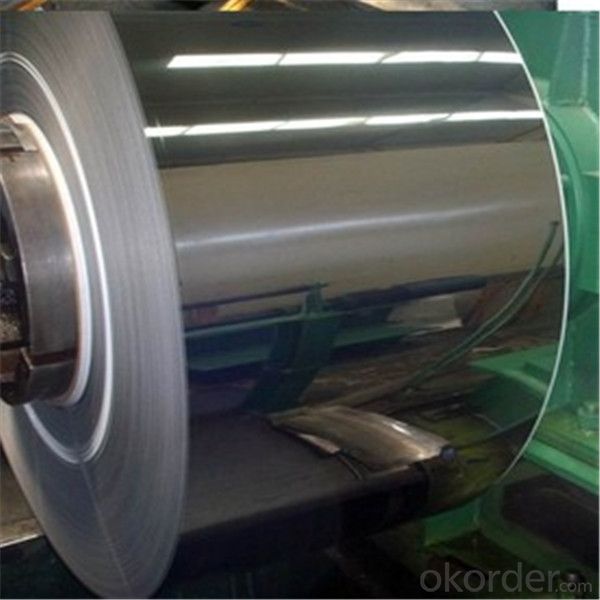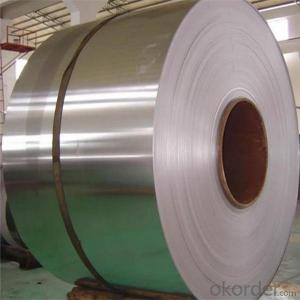Stainless Steel Coil Price Per KG in China
- Loading Port:
- Shanghai
- Payment Terms:
- TT OR LC
- Min Order Qty:
- 4 m.t.
- Supply Capability:
- 10000 m.t./month
OKorder Service Pledge
OKorder Financial Service
You Might Also Like
Item specifice
Detailed Product Description
Product Name: stainless steel coil
Features:
1) Grade: 430, 301,304, 316L, 201, 202, 410, 304
2) Specs: Thickness 0.3-3mm Width 20~ 480mm x C
We also produce other specification according to customer's requirements.
3) Executed Standard: JIS, ASTM, GB
4) Packing: plastic bag, weaving bag, wooden case or according to the customers
5) Applications: construction, decoration, machinery furniture, automobile, fluid transportation, Industry instrument, agriculture, kitchenware
6) Cold Rolling Thick:0.3mm-3.0mm Width:365-480
Specifications
Cold Rolled Stainless Steel Mill/Slit Coil
1. Grade: 200 & 300 series
200 seriers: 201,202, J4
300 seriers: 301, 304, 304L, 321, 316L, 309, 310S
2. Standard: JIS, ASTM, AISI, GB, DIN, EN, we usually use ASTM and GB Standard
3. Thickness: 0.14mm-3.0mm
4. Width: 10-700mm
5. Surface: 2B finished, BA finished
6. Hardness: soft, 1/4H, 1/2H, FH
7. Thickness Tolerance: +/-0.02mm
8. Width Tolerance: +/-10mm(mill edge)
Hot Rolled Stainless Steel Coil
1. Grade: 200 & 300 & 400 series
200 seriers: 201,202
300 seriers: 301, 304, 304L, 316L, 309, 310S,321
400 seriers: 410, 410S, 409L,430
2. Standard: JIS, ASTM, AISI, GB, DIN, EN, we usually use ASTM and GB Standard
3. Thickness: 2.4mm-6.0mm
200 series: 2.4mm-6.0mm
300 series: 2.4mm-6.0mm
400 series: 2.4mm-6.0mm
4. Width: 405mm-700mm
5. Surface: No1 finished, mill edge
6. Hardness: soft
7. Thickness Tolerance: +/-0.1mm
8. Width Tolerance: +/-10mm
9. Mills: Quanxing, Xingda

Producing Line of Stainless Steel Coil
1. 750mm 6-rolling mill (CR)
2. 850mm 2-rolling mill (HR)
5. 8 sets of bright annealing producing line (CR)
3. 8 sets of pickling and annealing line (HR)
6. 2 sets tension levelers
7. 2 sets degreasing cleaning lines
8. 4 sets slit cutting machine
9. 2 sets cutting plate machine
10. 1 set mulch applicator with PVC
11. 1 set wrapping machine

Applications
1.Automotive: Automotive trim and molding/Difficult-to-form exhaust-system components, tubular manifolds, mufflers/Exhaust manifold and other exhaust-system components, catalytic converter shells, clamps
2.Construction: Gutters and downspouts, roofing, siding
3.Kitchenware: Cooking utensils, dishwashers, ovens, range hoods, refrigerators, skewers
4.Chemical processing: Oil refinery equipment, oil burner and heater parts
5.Appliances: Hot water tanks, residential furnaces
6.Power generation: Heat Exchanger tubing
7.Farming:Dry fertilizer spreaders/Farm animal pens
- Q:How do stainless steel strips perform in high-pressure environments?
- Stainless steel strips have gained a reputation for their exceptional performance in high-pressure settings. They find widespread use in industries like oil and gas, chemical processing, and power generation, where they encounter extreme pressures and temperatures. One of the main advantages of stainless steel strips lies in their robustness and resistance to deformation. They possess the ability to endure intense pressure without distorting or compromising their structural integrity, making them an ideal choice for applications that demand reliability and durability. Furthermore, stainless steel strips exhibit excellent resistance to corrosion, particularly when alloyed with elements like chromium and nickel. This shields them from the detrimental effects of corrosive substances encountered in high-pressure environments, such as acids or salts. Their resistance to corrosion ensures that the strips retain their performance and structural strength over time. Another notable characteristic of stainless steel strips is their capacity to withstand high temperatures. They boast a high melting point and can endure extreme heat without deforming or weakening, making them suitable for applications involving elevated temperatures, such as heat exchangers or boilers. Additionally, stainless steel strips offer exceptional fatigue resistance, enabling them to withstand repeated cycles of pressure fluctuations without cracking or failing. This is especially crucial in high-pressure environments where the material is subjected to constant stress and strain. In conclusion, stainless steel strips are highly dependable and excel in high-pressure environments. Their strength, corrosion resistance, heat resistance, and fatigue resistance render them a preferred choice for various industries that prioritize reliability and performance.
- Q:Can 111 stainless steel strips be coated with anti-corrosion paints?
- 111 stainless steel strips can indeed be coated with anti-corrosion paints. Stainless steel possesses remarkable resistance to corrosion; nonetheless, there are specific environments or situations where supplementary safeguarding measures may become necessary. Anti-corrosion paints are specifically formulated to furnish an additional shield against corrosion by establishing a barrier between the steel surface and its surrounding environment. The application of these paints can effectively impede rusting, staining, as well as various other forms of corrosion on stainless steel. It is crucial to guarantee the compatibility of the chosen paint with stainless steel and adhere to appropriate application procedures to attain the best possible outcomes.
- Q:How does the price of stainless steel strips compare to other materials?
- The cost of stainless steel strips can fluctuate based on the particular grade and size of the strip, as well as the current state of the market. However, in general, stainless steel strips are typically pricier compared to alternative materials. This is primarily due to the higher expenses associated with production and the distinctive characteristics of stainless steel. Stainless steel is renowned for its exceptional resistance to corrosion, durability, and strength. It is also highly tolerant to heat and physical damage, making it suitable for a wide array of applications in various industries. These superior qualities contribute to the elevated price of stainless steel strips in comparison to other materials. On the other hand, materials such as carbon steel or aluminum are generally more economical. Carbon steel strips are extensively utilized due to their lower production costs and satisfactory strength properties. Aluminum strips, conversely, are lightweight and possess good corrosion resistance, but they are less robust and durable than stainless steel. When contemplating the price of stainless steel strips, it is crucial to assess the specific requirements of the intended use. Although stainless steel may necessitate a higher upfront investment, its long-term advantages, such as an extended lifespan and decreased maintenance costs, can make it a more cost-effective choice in many instances. Ultimately, numerous factors, including market demand, raw material availability, and manufacturing processes, influence the price of stainless steel strips. It is advisable to consult with suppliers or industry experts to obtain accurate and up-to-date pricing information for stainless steel strips and compare it with other materials in order to make an informed decision.
- Q:How do stainless steel strips handle exposure to chlorine?
- Stainless steel strips generally handle exposure to chlorine quite well. Chlorine is not usually corrosive to stainless steel, so the strips can withstand the effects of chlorine exposure without significant damage or degradation.
- Q:Can 111 stainless steel strips be used in the pulp and paper industry?
- Yes, 111 stainless steel strips can be used in the pulp and paper industry. Stainless steel strips are known for their corrosion resistance, durability, and strength, making them suitable for various industrial applications, including the pulp and paper industry.
- Q:Can stainless steel strips be used in water treatment applications?
- Yes, stainless steel strips can be used in water treatment applications. Stainless steel is highly resistant to corrosion and can withstand exposure to water, making it an ideal material for use in water treatment processes where the strips may come into contact with water or other liquids. Additionally, stainless steel has hygienic properties, is easy to clean, and has excellent longevity and durability, making it a suitable choice for water treatment applications.
- Q:Are stainless steel strips resistant to chloride stress corrosion cracking?
- Yes, stainless steel strips are generally resistant to chloride stress corrosion cracking due to the high levels of chromium and nickel present in the alloy, which provide excellent resistance to corrosive environments containing chlorides.
- Q:Are stainless steel strips suitable for medical applications?
- Stainless steel strips are indeed appropriate for medical purposes. They are highly favored in the medical field because of their exceptional resistance to corrosion, durability, and ease of sterilization. The notable levels of chromium found in stainless steel strips make them extremely resistant to corrosion, a crucial factor in maintaining a sterile environment for medical uses. Furthermore, stainless steel strips can endure the high temperatures and pressures typically encountered during the sterilization process. The material is also robust and long-lasting, enabling it to withstand the demands of medical procedures and equipment. In addition, stainless steel is biocompatible, ensuring that it does not react with bodily tissues or fluids, thus making it safe for implantable medical devices like surgical instruments, orthopedic implants, and prosthetics. All in all, stainless steel strips are a dependable and extensively utilized material in various medical applications due to their cleanliness, functionality, and compatibility with the human body.
- Q:What is the cost of stainless steel strips compared to other materials?
- The cost of stainless steel strips is generally higher compared to other materials due to its durability, corrosion resistance, and overall quality.
- Q:What are the different types of protective coatings for stainless steel strips?
- There exists a variety of protective coatings for stainless steel strips, each serving distinct purposes and offering varying levels of protection. 1. Paint Coatings: Paint is a commonly utilized protective coating for stainless steel strips. It creates a barrier against corrosion and enhances the steel's aesthetic appearance. Paint coatings can be applied in liquid or powder form, allowing for customization in terms of color and finish. 2. Powder Coatings: Powder coatings are another popular option for safeguarding stainless steel strips. These coatings are applied as dry powder and then heated to form a protective film. They provide exceptional durability and corrosion resistance, and are available in a wide range of colors and textures. 3. Electroplating: Electroplating involves bonding a thin layer of metal, like zinc or nickel, to the surface of the stainless steel. This coating acts as sacrificial protection against corrosion, making it ideal for harsh environments or exposure to corrosive substances. 4. PVD Coatings: Physical Vapor Deposition (PVD) coatings entail depositing a thin film of material onto the stainless steel surface using a vacuum chamber. These coatings offer superior durability, resistance to wear and corrosion, and can be tailored to provide specific properties like enhanced hardness or reduced friction. 5. Passivation: Passivation is a chemical treatment process that eliminates contaminants from the stainless steel surface and forms a passive oxide layer. This layer enhances the steel's natural resistance to corrosion. Passivation is often performed as a final step after fabrication or machining of stainless steel strips. 6. Organic Coatings: In industrial or marine environments, organic coatings like acrylics or epoxies are frequently employed to provide protection for stainless steel strips. These coatings exhibit resistance to chemicals, UV radiation, and abrasion, ensuring long-lasting defense against corrosion. It is crucial to select the appropriate protective coating for stainless steel strips, taking into consideration the specific application, environmental conditions, and desired level of protection. Seeking guidance from a coating specialist or manufacturer is advisable to ensure the most suitable coating is chosen for the intended use.
1. Manufacturer Overview |
|
|---|---|
| Location | |
| Year Established | |
| Annual Output Value | |
| Main Markets | |
| Company Certifications | |
2. Manufacturer Certificates |
|
|---|---|
| a) Certification Name | |
| Range | |
| Reference | |
| Validity Period | |
3. Manufacturer Capability |
|
|---|---|
| a)Trade Capacity | |
| Nearest Port | |
| Export Percentage | |
| No.of Employees in Trade Department | |
| Language Spoken: | |
| b)Factory Information | |
| Factory Size: | |
| No. of Production Lines | |
| Contract Manufacturing | |
| Product Price Range | |
Send your message to us
Stainless Steel Coil Price Per KG in China
- Loading Port:
- Shanghai
- Payment Terms:
- TT OR LC
- Min Order Qty:
- 4 m.t.
- Supply Capability:
- 10000 m.t./month
OKorder Service Pledge
OKorder Financial Service
Similar products
New products
Hot products
Hot Searches
Related keywords



























